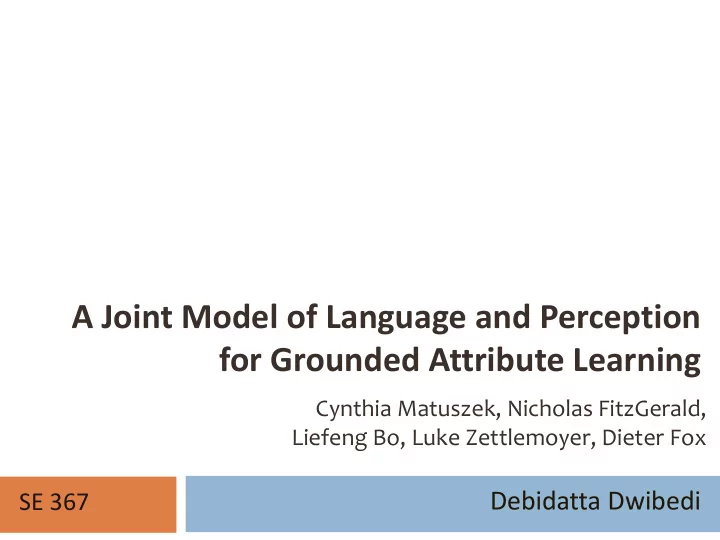

A Joint Model of Language and Perception for Grounded Attribute Learning Cynthia Matuszek, Nicholas FitzGerald, Liefeng Bo, Luke Zettlemoyer, Dieter Fox Debidatta Dwibedi SE 367
The Vision Robots should learn about their environment by interacting with humans Not by being programmed by them! Problems: Tough for the layman to ‘teach’ a robot Inability of the robot to make inductions Solutions: Point to object and describe in natural language Use language and perception to ground attributes like colors and shapes
Objective Select objects based on attribute Learn previously unknown attributes Yellow: new word describing new idea “ Which are the yellow objects ?”
Semantic Parsing • To produce the robot’s (mental?) representation • Combinatory Categorial Grammars [Steedman (book) 2000, Kwiatkowski et al 2010, 2011] used to parse sentences into lambda calculus expressions
Perceptual Model Segment objects from environment Set of binary classifiers each perceptual classifier is applied independently use logistic regression to train classifiers on colour and shape features Yellow Classifier
Joint Model Logical Sentence Form x z Subset of objects referred to by x among O G World Objects Model O w
Joint Model Logical Sentence Form x z Subset of objects referred to by x among O G World Objects Model O w
Unsupervised Learning x O G|O,x Initialization Train an initial supervised model from labeled scenes Learn new attributes Found N new attributes Add N new, unknown attribute classifiers Initialize to a small, near-uniform distribution Pair with every unknown word/phrase Expectation Maximization
Results
Results
Not all Humans are good Teachers Since people were told to describe the objects being pointed to in the manner they would do it to an infant, some descriptions are not helpful in learning attributes: “ This object is a fake piece of green lettuce. Do not try to eat! ” (Unexpected input) “ This is a toy ” (no attributes mentioned) “ This is a rectangular block ” when the block was cylindrical (Wrong descriptions due to noisy data or otherwise)
References A Joint Model of Language and Perception for Grounded Attribute Learning (2012) Cynthia Matuszek and FitzGerald, N. and Zettlemoyer, L. and Bo, L. and Fox, D.
Recommend
More recommend